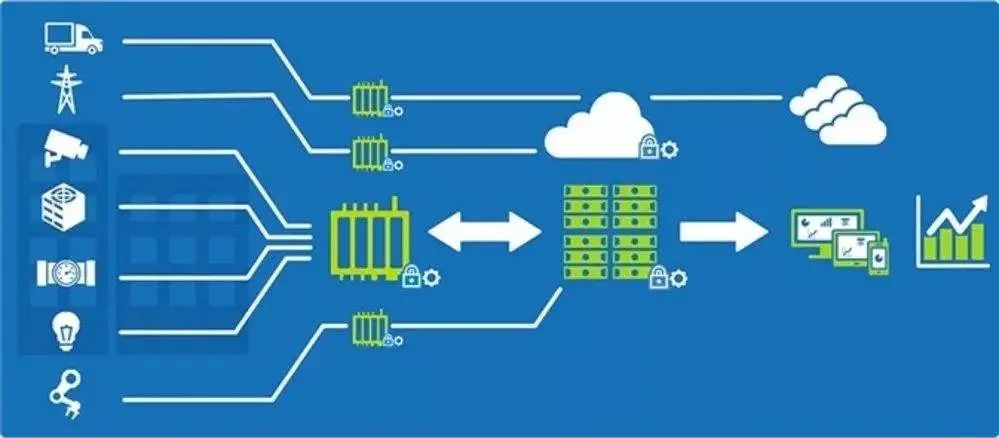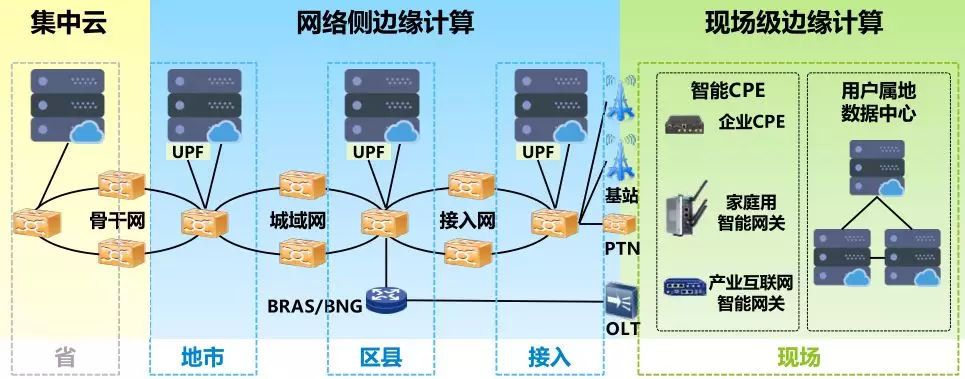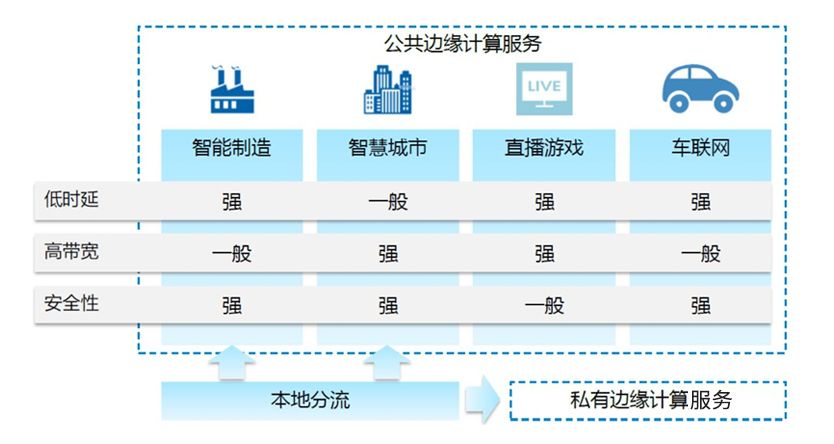

Editor’s Note:<Summary of Main Edge Computing Solutions> eBook covers technology development trends, industries, standard organizations, edge market space, hardware requirements, architecture, heterogeneous computing, mainstream players, and corresponding solution analysis. For details, refer to “Summary of Main Edge Computing Solutions”.
If we talk about the hottest concepts in the IoT circle in 2019, 5G and edge computing would definitely be on the list. Although they seem unrelated, they are actually interconnected in many ways.
In the 5G era, the number of connected devices will increase significantly, generating massive data at the network edge. While cloud computing can handle these issues, it has many shortcomings in terms of real-time performance, intelligence, security, and privacy, which is where edge computing comes into play. By adopting edge computing, massive data can be processed nearby, allowing numerous devices to work together efficiently and solving many problems.
To explore edge computing in detail and its relationship with 5G networks, you will see in this article:
-
What is edge computing
-
The value of edge computing
-
Application scenarios of edge computing
-
The relationship between edge computing and 5G
-
The prospects of edge computing and 5G
What is edge computing
To understand edge computing, we can use the living habits of octopuses as an analogy.
Octopuses are highly intelligent invertebrates. When hunting, they move very skillfully and quickly, with their arms working in perfect coordination, never tangling or knotting. This is because 60% of an octopus’s neurons are distributed in its eight arms, while only 40% are in its brain, resembling a structure of “multiple small brains + one large brain”, similar to distributed computing.
Edge computing is also a form of distributed computing. It offloads the processing of data, running of applications, and even the implementation of some functional services from the network center to the edge nodes, reducing multi-level transmission of services and alleviating the burden on the core network and transmission.
The Edge Computing Consortium (ECC) has defined four domains for edge computing: device domain (perception and control layer), network domain (connection and network layer), data domain (storage and service layer), and application domain (business and intelligence layer). These four “layers” are the computing objects of edge computing. Applications initiated at the edge (octopus arms) generate faster network service responses, meeting the basic needs of industries in real-time business, application intelligence, security, and privacy protection.
The value of edge computing
The core of edge computing is to provide computing, storage, and other infrastructure close to the data source or user, and to offer cloud services and IT environment services for edge applications. Edge computing is not only one of the important standards that distinguish 5G networks from 3G and 4G, but also a concrete network technology that supports the low latency and high density conditions of IoT technology, characterized by strong scene customization.

Compared to centralized cloud computing, edge computing not only solves issues like excessive latency and high traffic aggregation but also provides better support for real-time and bandwidth-intensive services. Overall, it has the following advantages:
Advantage 1: Higher Security
In edge computing, data is exchanged only between the source data device and the edge device, without being fully uploaded to the cloud computing platform, thus preventing the risk of data leakage.
Advantage 2: Low Latency
According to estimates from operators, if services are processed and forwarded by MEC deployed at the access point, latency can be controlled within 1ms; if services are processed and forwarded at the central processing network element of the access network, latency is about 2-5ms; even if processed by MEC within the edge data center, latency can be controlled within 10ms. For latency-sensitive scenarios like autonomous driving, edge computing, being closer to the data source, can quickly process data and make real-time judgments, ensuring passenger safety.
Advantage 3: Reduced Bandwidth Costs
Edge computing supports local data processing, and local offloading of high-traffic services can alleviate backhaul pressure and effectively reduce costs. For example, some connected sensors (like cameras or aggregation sensors working in engines) generate massive amounts of data. In such cases, sending all this information to the cloud computing center would take a long time and incur high costs. By using edge computing for processing, significant bandwidth costs can be reduced.

Thus, it can be seen that 5G is driving society from the era of human connection to the era of object connection. The significant increase in the number of connections, combined with the advantages of edge computing, will make it an indispensable part of the 5G era. Additionally, the demand for computing power brought about by edge computing will become an important incremental part of the 5G era.
Application Scenarios of Edge Computing
According to the “China Mobile Edge Computing White Paper” released by China Mobile, the demand for edge computing is most evident in four vertical fields: smart manufacturing, smart cities, live gaming, and the Internet of Vehicles.
In the smart manufacturing sector, factories utilize edge computing smart gateways for local data collection and perform real-time processing such as data filtering and cleaning. Edge computing can also provide cross-layer protocol conversion capabilities to achieve unified access to fragmented industrial networks.
In the smart city sector, applications mainly focus on smart buildings, logistics, and video surveillance. Edge computing can achieve on-site collection and analysis of various operational parameters of buildings and provide predictive maintenance capabilities; monitor and warn about vehicles and goods in cold chain transportation; and utilize locally deployed GPU servers to achieve millisecond-level facial recognition, object recognition, and other intelligent image analysis.
In the live gaming sector, edge computing can provide rich storage resources for CDN and offer audio and video rendering capabilities closer to users, making new business models like cloud desktops and cloud gaming possible. Especially in AR/VR scenarios, the introduction of edge computing can significantly reduce the complexity of AR/VR terminal devices, thereby lowering costs and promoting rapid development of the overall industry.
In the Internet of Vehicles sector, the demand for latency is very stringent. Edge computing can provide millisecond-level latency guarantees for collision avoidance, platooning, and other autonomous/assisted driving services, while also providing computing power locally at the base station to support high-precision map data processing and analysis, better supporting blind spot warning services.

What is the Relationship Between Edge Computing and 5G?
The relationship between edge computing and 5G can be summarized in one word: mutual support.
“Mutual support”: can be interpreted as the horns of cattle, sheep, and deer growing at a certain distance from each other, thus visualizing the situation of two different places occupied by troops during battle. The relationship between edge computing and 5G is somewhat similar; on one hand, edge computing plays an important supporting role in the development of 5G, while on the other hand, the development of 5G also promotes the prosperity of the edge computing industry.
Edge Computing Makes 5G Possible
It is well known that when 5G networks were first conceived, three major application scenarios were defined: eMBB (enhanced mobile broadband), mMTC (massive machine-type communication), and uRLLC (ultra-reliable low-latency communication), providing technical support for high-definition video, smart cities, and the Internet of Vehicles.
However, it is worth noting that each application scenario faces its own challenges. For example, eMBB will generate an extremely high demand for network bandwidth of hundreds of Gbps, putting tremendous transmission pressure on the backhaul network. Simply investing in expanding aggregation and metropolitan networks will significantly increase the cost of media stream transmission, making it impossible to achieve a return on investment; uRLLC requires end-to-end ultra-low latency support of 1ms, which cannot be met solely by advancements in wireless and fixed network physical layer and transport layer technologies; mMTC will generate massive data, leading to significant operational management challenges, which cannot be supported by centralized monitoring from the cloud for such a complex IoT system.
Edge computing can provide solutions to these problems. First, edge computing devices will provide connectivity and protection for new and existing edge devices; second, while 5G will offer better connectivity and lower latency for cloud-based applications, there are still costs associated with processing and storing data. Hybrid edge computing/5G solutions will reduce these costs; finally, edge computing can allow more applications to run at the edge, such as analytics, network security, or compliance/regulatory applications, reducing latency caused by data transmission speed and bandwidth limitations, and performing preliminary analysis on local data, relieving some of the workload from the cloud.
5G Accelerates Edge Computing
Not only does edge computing promote 5G, but 5G and edge computing are complementary to some extent. On one hand, thanks to the development of 5G itself, it will directly promote the development of edge computing; on the other hand, since 5G promotes the Internet of Things, it will indirectly promote edge computing.
As mentioned earlier, while 5G development still faces some challenges, edge computing can solve these problems. Therefore, as 5G is in the last mile before commercial use, related companies will invest more energy and resources into important supporting technologies, allowing edge computing to “ride the wave” and develop vigorously.
Additionally, the promoting effect of 5G on the Internet of Things is also evident. Thanks to the support of 5G technology, fields such as smart homes, smart cities, the Internet of Vehicles, and industrial internet will experience significant development, which will in turn generate a massive amount of data. The characteristics of massive data and real-time processing pose new requirements for data processing technologies, and current data processing methods are insufficient to meet these demands. The emergence of edge computing brings many benefits to this challenge.
The Development of 5G and Edge Computing
Although 5G is currently a hot topic and edge computing has also become a focus, as Huawei’s Ren Zhengfei mentioned, 5G may be overhyped, and the shortcomings of both 5G and edge computing are objectively present: the scale and progress of 5G construction are not as expected, the development of edge computing technology is not as expected, and operator investments are not as expected.
According to Gartner’s predictions, by 2022, half of the communication service providers that complete commercial 5G deployments will struggle to profit from their investments in backend technology infrastructure due to systems not fully meeting the demands of 5G use cases. Most communication service providers will have to wait until 2025 to 2030 to achieve a complete end-to-end 5G infrastructure on their public networks, as they will first focus on 5G radio communication, followed by core network slicing and edge computing.
The deployment of edge computing is primarily driven by business needs, constrained by latency and bandwidth limitations, with latency being a rigid constraint. While 5G is expected to solve some issues in related fields, the development of edge computing still requires a deep understanding of customer and business needs, as well as the maturity of the overall industry chain.
Thus, it can be seen that since 5G and edge computing are complementary, when the development of 5G does not meet expectations, it will be difficult for edge computing to reach the desired state. The development of the two is inseparable, and market prosperity will still take time.
Editor’s Statement:This content is adapted from websites such as Zhiding and Financial界.
Original Link:
https://mp.weixin.qq.com/s/5QAHPMM8SNE3J8fpmDKFaQ
Recommended Reading:Summary of Main Edge Computing Solutions

Reprint Statement: Please indicate the author and source when reprinting articles from this account. If there are copyright issues with articles published by this account, please leave a message for processing. Thank you.
Recommended Reading
For more architecture-related technology knowledge summaries, please refer to the “Architects’ Technical Alliance Bookstore” related eBooks (35 books of technical materials packaged together can be obtained through “Read the original“.
Content is continuously updated. Currently, order the “Complete Package of Architect’s Technical Store” to enjoy free updates of all store content later, priced at 188 yuan (original total price 270 yuan).
Warm Reminder:
Scan theQR code to follow the public account, clickRead the original link to get the details of the “Complete Package of Architect’s Technical Store” eBook materials.
